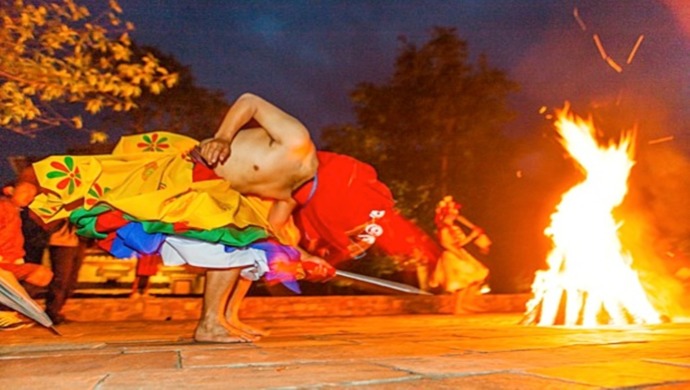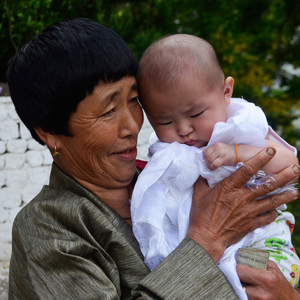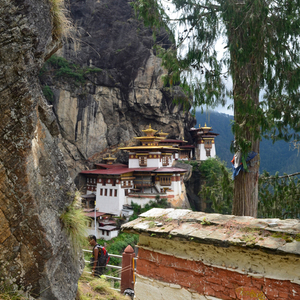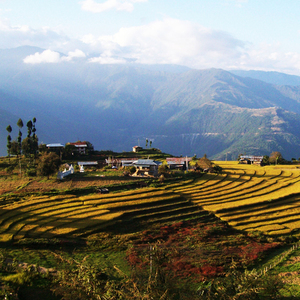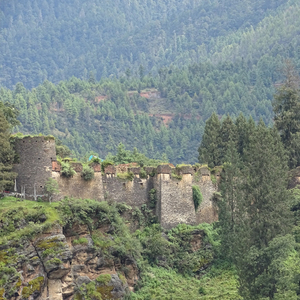Day 1. Paro - Thimphu:
Driving Distance: 65 Kms, Driving time: 1.50 hrs – 2 hrs, Altitude of Thimphu: 2,350 m
Your flight to Paro on a clear day, is marked with the panoramic views of the Himalayas including the Everest and other famous Peaks. The approach through the foothills and the landing (including few steep turns) at the tiny airstrip of Paro has been termed as adventurous by many travelers. After the completion of immigration formalities at the Paro Airport exit door, you will be received by your Bhutanese guide with traditional “Tashi Khadar”. Afterwards drive to Thimphu following the Pa Chhu River. Check-In to the hotel and have your first experience with Bhutanese Cuisine. Rest of the day is at leisure. You can explore the Thimphu valley and town or shop till your heart’s content.
Meals – Lunch and Dinner; Overnight at the Hotel in Thimphu.
Day 2. Thimphu Sightseeing:
Today you would be driven in and around Thimphu covering key places of interest. After breakfast you would visit
- Kuensel Phodrang, the gigantic Buddha Dordenma Statue located atop a hill in Kuensel Phodrang Nature Park.
- National Memorial Chhorten, a Stupa built in 1974 to honor the third Druk Gyalpo, Jigme Dorji Wangchuck. Every morning till night old people and young people circumambulate the Chhorten. You may choose to light butter lamps and also circumambulate around the Chorten.
- Zorig Chusum, Premier institute of traditional arts and crafts in Thimphu established with an objective of preserving “thirteen arts and crafts of Bhutan”.
- Folk Heritage, traditional house giving an insight to the Bhutanese lifestyle, and artifacts from the rural households
Thereafter, you would be taken to a local restaurant for lunch. In the afternoon you would be taken to
- Sangaygang View Point, also known as BBS Tower offering panoramic view of Thimphu Town situated at an elevation of 2,685 m.
- Changangkha Monastery, popular fortress like temple perched on a ridge above Central Thimphu built in 15th Century by Lama Phajo Drugom Zhipo.
- Takin Preserve Centre, see Takin (National animal of Bhutan) It is a unique combination of Goat and an Antelope
- Tashichhodzong, or ‘the fortress of the glorious religion’. Initially erected in 1641 by Shabdrung Ngawang Namgyal, it was rebuilt in the 1960s during the reign of Bhutan’s third king in the traditional style, without plans or nails. It houses some ministries, His Majesty’s secretariat, and the central monk body and opens after 5 PM.
On the completion of sightseeing, you are driven back to your hotel. After relaxing for some time you shall be served with dinner.
Meals – Breakfast, Lunch and Dinner; Overnight at the Hotel in Thimphu.
Day 3. Thimphu - Gangtey/Phobjikha:
Driving Distance: 140 Kms, Driving time: 4 hrs - 5 hrs, Altitude of Gangtey/Phobjikha: 2900 m
After breakfast and completion of check out formalities, you are driven to Gangtey/Phobjikha. On the way stop at
- Dochula Pass, lies at an elevation of 3,150 m and is a great place to view the higher Himalayas. The landmarks around the pass includes 108 Druk Wangyal Stupas built under the patronage of Queen Ashi Dorji Wangmo Wangchuk.
Thereafter, you continue your drive to Gangtey/Phobjikha. Enroute, we would stop for lunch. While in Gangtey, visit the
- Gangtey Goemba, an important monastery of Nyingmapa school of Buddhism, the main seat of the Pema Lingpa tradition. The present Abbot, Kunzang Pema Namgyal is the ninth re-incarnation. It is one of the largest Nyingma monastery in Bhutan.
- Black Necked Crane Information Centre, a place for recreation with crane watching equipment (binoculars, spotting scopes) and reference books
After the completion of sightseeing, you are driven back to your hotel. Evening free for relaxation.
Meals – Breakfast, Lunch and Dinner; Overnight at the Hotel in Phobjika/Gangtey.
Day 4. Gangtey/ Phobjikha Valley:
A full day to explore at the
- Phobjikha Valley, one of the most beautiful glacial valleys in the Himalayas. It lies at an elevation of 3,000 m. It is surrounded by many small villages. Phobjikha is best known for the rare black necked cranes that migrate here from the Tibetan Plateau to avoid the extremely cold winters.
Today, you would have a typical Bhutanese Cuisine at a farmhouse. Later, you may choose to do any of the following: Visiting villages and interacting with People, Hikes around the valley, Photography, etc.
Finally, to drive back to the hotel. Evening free for leisure.
Meals – Breakfast, Lunch and Dinner; Overnight at the Hotel in Phobjika/Gangtey.
Day 5. Gangtey - Trongsa - Bumthang:
Distance: 188 kms, Driving Time: 6 hrs - 7 hrs. Altitude of Bumthang: 2600 m.
After breakfast, check out from hotel and drive to Trongsa across Pele-La-Pass (11.120 ft.). Here you would witness an abrupt change in vegetation, with mountain forest replaced by high altitude dwarf bamboos. On the way stop at
- Chendbji Chhorten, built during the 18th century by Lama Shida in the style of the great Boudhanath Chhorten of Nepal to cover the remains of an evil spirit which is said to have manifested as a gigantic snake.
Further ahead visit
- Trongsa Dzong, the seat of power over Central and Eastern Bhutan. It was built by Chogyal Minjur Tempa was later enlarged at the end of the 17th century by Desi Tenzin Rabgay. Trongsa Dzong is the ancestral home of the present Royal Family. The first two hereditary kings ruled Bhutan from this Dzong.
- Ta Dzong, an ancient watch tower built in the year 1652 by Chogyal Minjur Tempaa as per the directions of Shabdrung Ngawang Namgyal. It has been converted into a museum and represents a tasteful blend of tradition and modernity.
Drive further to Bumthang over the Yutong-La-Pass (11,155 ft.). Enroute stop for lunch. While in Chumey valley in Bumthang, visit the
- Yathra Weaving Factory, located in the Zungye village in Chumey, around 17 kms approximately, before reaching the main town of Bumthang. Yathra is the most famous textile product of Bumthang. Yathra is a hand woven fabric made from the wool of sheep or Yak.
On arrival check in at the hotel. Evening free for leisure and walk in the valley.
Meals – Breakfast, Lunch and Dinner; Overnight at hotel in Bumthang.
(Note: the roads to Bumthang are not good due road widening work going on)
Day 6. Bumthang Sightseeing:
Festival Day 1
After breakfast, you would be taken around the city to visit the
- Jakar Dzong, literally meaning the Castle of White Bird. The current structure was built in 1667. Jakar Dzong is now the main administrative center for Bumthang District, the Dzong also houses the regional monk body.
- Chakhar Lhakhang, literally meaning the Iron Castle. The original palace was made of Iron and hence the name “Chakhar”. It was rebuilt in 14th century by Dorji Lingpa, a Buddhist saint.
- Kurjey Lhakhang, named after body print of Guru Rimpoche. It consists of three temples. The first temple was built in the year 1652 on the rock face, where Guru Padmasambhava meditated in the 8th century. The second temple is considered to be the most holy as it is built on the site of the cave which contains the imprint of the Guru's body. In the year 1990, Ashi Kesang, the Queen mother built the third temple. All the three temples are surrounded by 108 chorten wall.
Thereafter you would be taken to a local restaurant for lunch. Rest of the afternoon free for leisure. Later in the evening, you would be taken to Jambay Lhakhang to witness day 1 of the festival. The first day of the festival begins at late night. Your guide would let you know your exact timings.
- Day – 1 - The highlight of the first day is Mewang “fire dance” which takes place in the evening to bless the people who witness and participate. The other distinct feature of this festival is the Ter Cham, “the naked dance”, performed at night. Photography is not permitted during these rituals.
Meals – Breakfast, Lunch and Dinner; Overnight at hotel in Bumthang.
Day 7. Bumthang Sightseeing:
Festival Day 2
After breakfast, we would again be taken to Jambay Lhakhang to attend Day 2 of the festival.
- Day 2 - You would notice that the dances are performed by both monks and laymen according to steps meticulously choreographed by Buddhist masters in the past. These steps are filled with religious symbols that it will not be easy for Non-Bhutanese people to understand without guide’s help. You would also hear folk songs performed on the occasion. Apart from being a religious affair, it is also a social event. People gather at the local temple in their best Gho and Kira with packed lunches and make merry. You would see how locals from far off places dressed in their finest clothes come to watch masked dances, to pray, to feast and to enjoy the atmosphere.
Post lunch, you would be taken to:
- Tamshing Lhakhang, literally meaning the Temple of the good message. It was established in 1501 by Terton Pema Lingpa and has ancient religious paintings such as 1000 Buddhas and 21 'Taras' (female form of Bodhisattva).
- Membar Tsho, also known as “The burning Lake”. It is one of the most sacred sites in the region and relates to the famous treasure revealer, Terton Pema Lingpa. Following a prophecy by Guru Rinpoche, Terton Pema Lingpa unearthed a treasure from the bottom of the lake. He dived into the lake with a burning butter lamp and reappeared with the butter lamp still burning and a chest and scroll of paper in his hand (treasures)
After completing the sightseeing, you would return to your hotel for dinner and retire for the night.
Meals – Breakfast, Lunch and Dinner; Overnight at hotel in Bumthang.
Day 8. Bumthang - Punakha/Wangdue:
Distance: 220 kms, Driving Time: 8 hrs - 9 hrs, Altitude of Punakha: 1310 m.
After breakfast, check out from hotel and drive to Punakha/Wangdue. On the way stop for Lunch. After arrival check into the hotel. Evening free for leisure.
Meals – Breakfast, Lunch and Dinner; Overnight at Hotel in Punakha/Wangdue.
Day 9. Punakha/Wangdue Sightseeing:
After breakfast, you would be visiting
- Khamsum Yulley Namgyel Monastery, a monastery that stands majestically on a strategic ridge above the Punakha valley. Built over a period of 9 years, Bhutanese craftsmen consulted holy scriptures rather than engineering manuals, to construct this 4-storey temple. It takes an hour to hike to the Temple passing through rice fields on the way.
After lunch, you would visit
- Punakha Dzong, built in 1637 by Shabdrung Ngawang Namgyal. For many years until the time of the second King, it served as the seat of the Government. It is still the winter residence of Je-Khenpo (The Chief Abbot of the Central Monastic Body of Bhutan)
- Chhimi Lhakhang, a famous Temple, which is also known as “The Temple of Fertility” built by Lama Drukpa Kuenley
After Chhimi Lhakhang, you would come back to your hotel. Evening free for leisure.
Meals – Breakfast, Lunch and Dinner; Overnight at Hotel in Punakha/Wangdue.
Day 10. Punakha - Paro:
Driving Distance: 135 kms, Driving Time: 4 hrs - 5 hrs, Altitude of Paro: 2280 m
After breakfast, you would check out of the hotel to proceed to Paro, final leg of the tour. On the way stop at
- Royal Botanical Park, Lamperi, also known as the Rhododendron Garden, is the first Botanical Garden of Bhutan. It is famous for 46 species of rhododendrons.
After arriving at Paro, you would be transferred to you Hotel for Check In. After lunch, you would be taken around to visit
- Paro Rimpung Dzong, also known as Fortress of the heap of jewels, built during the time of Shabdrung Ngawang Namgyal in 1646
- Ta Dzong, an ancient watch tower overlooking Rimpung Dzong built in 1951 now converted into national museum.
Evening is free for leisure activities and shopping.
Meals – Breakfast, Lunch and Dinner; Overnight at the Hotel in Paro.
Day 11. Paro Sightseeing:
After breakfast, start your day with a hike to
- Taktsang Monastery (Tiger's nest), the abode of gods and monks situated at an altitude of 3100m on the Upper Paro Valley, Bhutan. As per the legend, Guru Padmasambhana (Guru Rinpoche), the tantrum mystic who brought Buddhism to Bhutan, came in the form of Dorje Droloe riding a flying tigress to subdue the demon that was obstructing the spread of Buddhism in the Himalayas.
After the completion of the hike, you would be served picnic Lunch among the woods. After lunch, visit
- Kyichu Lhakhang, one of the oldest monasteries in Bhutan built in the 7th century by the Tibetan Emperor Songtsen Gampo
You would then drive to village house to witness the traditional rural life in a Bhutanese village. Also you have an option of experiencing a Traditional Hot Stone bath in the village house. You can also choose to have your dinner in the house with the Family (needed to be confirmed at the time of confirmation of the Tour) or be driven back to your hotel.
Meals – Breakfast, Lunch and Dinner; Overnight at the Hotel in Paro.
Day 12. Departure:
Today we will bid farewell to this beautiful country and take an early flight back. We hope by now you must have made some good friends and also have taken photographs and beautiful memories of Bhutan. We certainly hope of serving you again on your next visit to this great country or the Last Shangri-La. Tashi Delek
